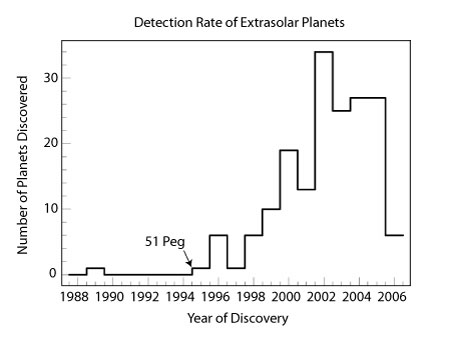In astronomically inclined households, the first wave of extrasolar planets to be discovered, 51 Peg, 70 Vir, Ups And, Tau Boo, are all still household names.

With the later additions to the census, however, such as HD 33283 b et al., even the discoverers can have a hard time keeping the names in mind. In part, this is because it’s tough to keep a bunch of random Henry Draper Catalog numbers at the tip of the tongue. It’s also because planets #184, #185, and #186 don’t quite pack the same panache as planets #2, #3, and #4. Maybe it’s time to start naming these planets?
It’s easy to get the impression that the rate of discovery of extrasolar planets is increasing rapidly with time. Interestingly, however, this hasn’t been the case recently. The planet discovery rate peaked in 2002, with 34 planets detected, and the rate over the last four years has been flat, at about 25 planets per year. (The present year has brought us six new worlds during the span between New Years Day and Earth Day):

The detection rate has flattened for several reasons. After a decade’s worth of planet discoveries, the Doppler radial velocity method remains the most productive technique. The radial velocity method is most efficient when one has a bright parent star. Most of the suitable stars with V magnitudes brighter than 8 are already on the Doppler Surveys. The readily detectable short-period planets orbiting these stars have mostly been found. The much longer orbital periods of the outer planets mean that one must be increasingly patient as one waits for new discoveries from venerable stars. Indeed, the detection rate of planets over the past several years would be even lower, were it not for targeted Doppler surveys such as N2K, which are specifically designed to find new planets quickly by surveying metal-rich stars.
The transit and microlensing methods have a lot of promise for upping the planet detection rate, but to date, very few planets have been discovered with these techniques. In an upcoming post, we’ll look in more detail at the reasons why this has been the case.
It’s interesting to compare the planet detection rate with the history of minor planet detections. Ceres, the first minor planet to be discovered, was found in 1801, followed by Pallas in 1802, Juno in 1804, and Vesta in 1807. A thirty-eight year gap followed, until the discovery of Astraea in 1845. The 100th asteroid, Hecate, was found in Ann Arbor Michigan in 1868, and asteroid #188 (equal to the number of extrasolar planets currently known) Minippe was found ten years later in 1878. The rate has increased rapidly since then. As of last November, there were 120,437 numbered asteroids:

I think it will take about 15 more years to find 120,437 planets.

Pingback: Centauri Dreams » Blog Archive » Three Planets, and a New Category
You must be talking about ONLY numbered asteroids. The recent drop is due to a bottleneck in the numbering system >100,000. The actually discoveries of minor planet has been at a near all top high in the last few years!